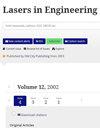谐振腔蜂窝状PCM冷却反射镜的热变形实验研究
IF 0.5
4区 工程技术
Q4 MATERIALS SCIENCE, MULTIDISCIPLINARY
引用次数: 2
摘要
提出了一种用于高功率激光器谐振腔的相变材料(PCM)冷却反射镜。PCM冷却反射镜可以有效地减小反射表面的热变形。设计了实验装置,实时测量了蜂窝状PCM冷却反射镜的激光诱导热变形。与固体硅反射镜相比,在吸收140 W净热后,激光照射第10秒时,其直径仅为0.45µm。此外,通过实验研究了支撑方式对热变形的影响,证明了简单支撑与PCM冷却反射镜是兼容的。本文章由计算机程序翻译,如有差异,请以英文原文为准。
Experimental study of thermal deformation of honeycombed PCM cooled mirror in resonator
A new kind of phase change material (PCM) cooled mirror for use in the resonator of high power lasers is proposed. The PCM cooled mirror can minimize the thermal deformation on the reflecting surface effectively. A test setup was designed and the laser-induced thermal deformation of honeycombed PCM cooled mirror was measured at real time. Compared with a solid silicon mirror, it was only 0.45 µm at the tenth second of laser irradiation after absorbing 140 W net heat. In addition, the influence of the method of support on the thermal deformation was studied by experiments and showed that a simple support is compatible with a PCM cooled mirror.
求助全文
通过发布文献求助,成功后即可免费获取论文全文。
去求助
来源期刊

Lasers in Engineering
工程技术-材料科学:综合
CiteScore
1.00
自引率
20.00%
发文量
0
审稿时长
3.4 months
期刊介绍:
Lasers in Engineering publishes original (primary) research articles, reviews, short communications and letters on all aspects relating to the application of lasers in the many different branches of engineering and related disciplines.
The topics covered by Lasers in Engineering are the use of lasers: in sensors or measuring and for mapping devices; in electrocomponent fabrication; for materials processing; as integral parts of production assemblies; within the fields of biotechnology and bioengineering; in micro- and nanofabrication; as well as the materials and processing aspects of techniques such as cutting, drilling, marking, cladding, additive manufacturing (AM), alloying, welding and surface treatment and engineering.
Lasers in Engineering presents a balanced account of future developments, fundamental aspects and industrial innovations driven by the deployment of lasers. Modern technology has a vitally important role to play in meeting the increasingly stringent demands made on material and production systems. Lasers in Engineering provides a readily accessible medium for the rapid reporting of new knowledge, and technological and scientific advances in these areas.
 求助内容:
求助内容: 应助结果提醒方式:
应助结果提醒方式:


